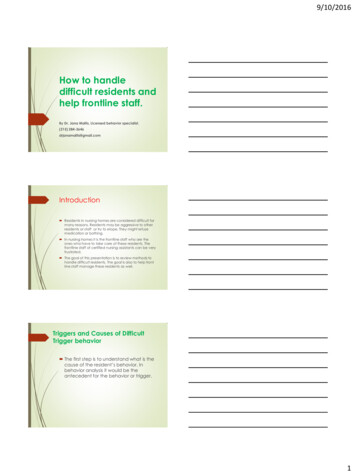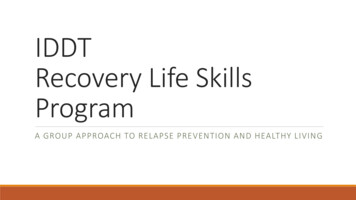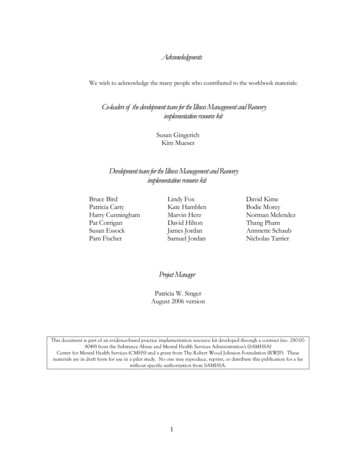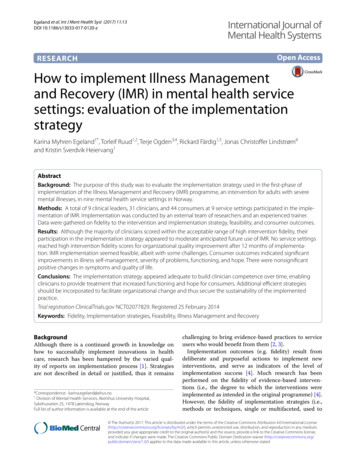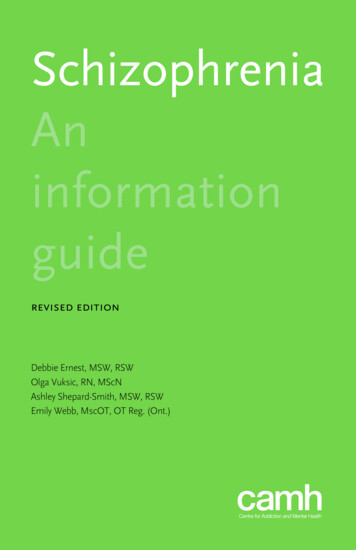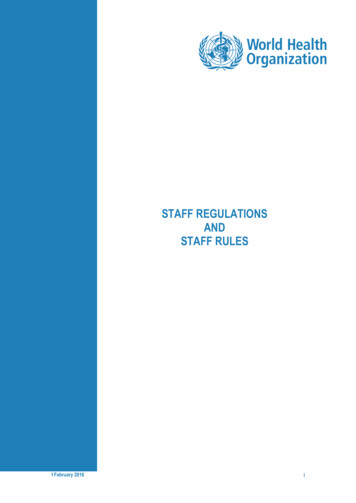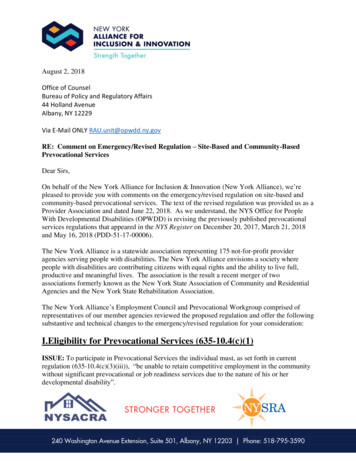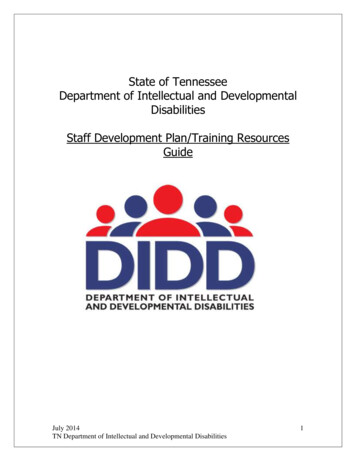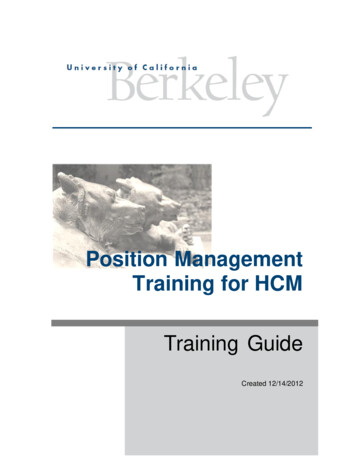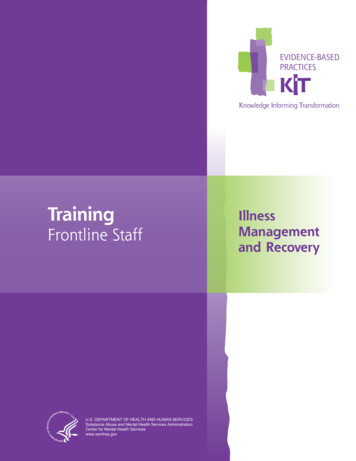
Transcription
TrainingFrontline StaffU.S. DEPARTMENT OF HEALTH AND HUMAN SERVICESSubstance Abuse and Mental Health Services AdministrationCenter for Mental Health Serviceswww.samhsa.govIllnessManagementand Recovery
TrainingFrontline StaffU.S. Department of Health and Human ServicesSubstance Abuse and Mental Health Services AdministrationCenter for Mental Health ServicesIllnessManagementand Recovery
AcknowledgmentsThis document was prepared for the Substance Abuse and Mental Health Services Administration(SAMHSA) by the New Hampshire-Dartmouth Psychiatric Research Center under contract number280-00-8049 and Westat under contract number 270-03-6005, with SAMHSA, U.S. Departmentof Health and Human Services (HHS). Pamela Fischer, Ph.D., and Crystal Blyler, Ph.D., served asSAMHSA Government Project Officers.DisclaimerThe views, opinions, and content of this publication are those of the authors and contributors anddo not necessarily reflect the views, opinions, or policies of the Center for Mental Health Services(CMHS), SAMHSA, or HHS.Public Domain NoticeAll material appearing in this document is in the public domain and may be reproducedor copied without permission from SAMHSA. Citation of the source is appreciated. However,this publication may not be reproduced or distributed for a fee without the specific, writtenauthorization from the Office of Communications, SAMHSA, HHS.Electronic Access and Copies of PublicationThis publication may be downloaded or ordered at http://www.samhsa.gov/shin. Or, pleasecall SAMHSA’s Health Information Network at 1-877-SAMHSA-7 (1-877-726-4727) (Englishand Español).Recommended CitationSubstance Abuse and Mental Health Services Administration. Illness Management and Recovery:Training Frontline Staff. HHS Pub. No. SMA-09-4462, Rockville, MD: Center for Mental HealthServices, Substance Abuse and Mental Health Services Administration, U.S. Department of Healthand Human Services, 2009.Originating OfficeCenter for Mental Health ServicesSubstance Abuse and Mental Health Services Administration1 Choke Cherry RoadRockville, MD 20857HHS Publication No. SMA-09-4462Printed 2009
Training Frontline StaffThis four-part workbook will help Illness Managementand Recovery (IMR) leaders teach practitioners about theprinciples, processes, and skills necessary to deliver effectiveIllness Management and Recovery services. The workbookincludes the following topics:n Basic elements and core values;n Core processes;n Recovery and the Stress-Vulnerability Model; andn Motivational, educational, and cognitive-behavioralstrategies.The CD-ROM included in this KIT contains the Practitioner Guidesand Handouts booklet which includes all of the guides, handouts,and forms that practitioners use to provide Illness Managementand Recovery to consumers. Use both the CD-ROM and theTraining Frontline Staff booklet to train practitioners.For references, see the booklet The Evidence.IllnessManagementand Recovery
This KIT is part of a series of Evidence-Based Practices KITs createdby the Center for Mental Health Services, Substance Abuse andMental Health Services Administration, U.S. Department of Healthand Human Services.This booklet is part of the Illness Management and Recovery KITthat includes a DVD, CD-ROM, and seven booklets:How to Use the Evidence-Based Practices KITsGetting Started with Evidence-Based PracticesBuilding Your ProgramTraining Frontline StaffEvaluating Your ProgramThe EvidenceUsing Multimedia to Introduce Your EBP
What’s in Training Frontline StaffHow Program Leaders Should Use This Workbook . . . . ADecide on your program format. . . . . . . . . . . . . . . . . . . . . . BPrepare program-specific information. . . . . . . . . . . . . . . . . . BPrepare agency-specific information. . . . . . . . . . . . . . . . . . . CVisit an existing team . . . . . . . . . . . . . . . . . . . . . . . . . . . . . CArrange for didactic training . . . . . . . . . . . . . . . . . . . . . . . . CRecruit a consultant. . . . . . . . . . . . . . . . . . . . . . . . . . . . . . . CCross-train . . . . . . . . . . . . . . . . . . . . . . . . . . . . . . . . . . . . . DModule 1. . . . . . . . . . . . . . . . . . . . . . . . . . . . . . . 1Basic Elements and Core Values . . . . . . . . . . . . . . . . . . . . . . 1What is Illness Management and Recovery? . . . . . . . . . . . . . 1Practice principles. . . . . . . . . . . . . . . . . . . . . . . . . . . . . . . . 3Program standards . . . . . . . . . . . . . . . . . . . . . . . . . . . . . . . 5How we know that Illness Managementand Recovery is effective. . . . . . . . . . . . . . . . . . . . . . . . . . . 5Core components of Illness Management and Recovery. . . . . 5Core values in Illness Management and Recovery . . . . . . . . . 6Summary. . . . . . . . . . . . . . . . . . . . . . . . . . . . . . . . . . . . . . 8Exercise: Explore the Benefits of Illness Managementand Recovery . . . . . . . . . . . . . . . . . . . . . . . . . . . . . . . . . . . 9Exercise: Identify Consumers . . . . . . . . . . . . . . . . . . . . . . . 11Exercise: Introduce Your Program. . . . . . . . . . . . . . . . . . . . 13Module 2. . . . . . . . . . . . . . . . . . . . . . . . . . . . . . . 1Core Processes. . . . . . . . . . . . . . . . . . . . . . . . . . . . . . . . . . 1Engaging consumers is a continuous process. . . . . . . . . . . . . 2Assess consumers’ knowledge and skill level . . . . . . . . . . . . . 2IllnessManagementand Recovery
Follow the curriculum . . . . . . . . . . . . . . . . . . . . . . . . . . . . . 2Use Practitioner Guides. . . . . . . . . . . . . . . . . . . . . . . . . . . . 3Use Handouts for consumers. . . . . . . . . . . . . . . . . . . . . . . . 3Pace your sessions. . . . . . . . . . . . . . . . . . . . . . . . . . . . . . . . 4Consider the format of your sessions. . . . . . . . . . . . . . . . . . . 4Structure your sessions. . . . . . . . . . . . . . . . . . . . . . . . . . . . . 5Provide homework assignments . . . . . . . . . . . . . . . . . . . . . . 5Follow up on homework assignments. . . . . . . . . . . . . . . . . . 6Setting and pursuing goals . . . . . . . . . . . . . . . . . . . . . . . . . 6Involve other supporters . . . . . . . . . . . . . . . . . . . . . . . . . . . 7Complete Progress Notes. . . . . . . . . . . . . . . . . . . . . . . . . . . 8Participate in supervision. . . . . . . . . . . . . . . . . . . . . . . . . . . 8Summary. . . . . . . . . . . . . . . . . . . . . . . . . . . . . . . . . . . . . . 8Exercise: Compare Assessment Procedures. . . . . . . . . . . . . . . 9Exercise: Complete a Progress Note . . . . . . . . . . . . . . . . . . 11Exercise: Involve Other Supporters. . . . . . . . . . . . . . . . . . . 13Exercise: Improve Your Program. . . . . . . . . . . . . . . . . . . . . 15Module 3. . . . . . . . . . . . . . . . . . . . . . . . . . . . . . . 1Recovery and the Stress-Vulnerability Model. . . . . . . . . . . . . 1Recovery means more than just coping. . . . . . . . . . . . . . . . . 2Learn from other perspectives . . . . . . . . . . . . . . . . . . . . . . . 3Think about recovery as a process. . . . . . . . . . . . . . . . . . . . . 3Convey hope. . . . . . . . . . . . . . . . . . . . . . . . . . . . . . . . . . . . 4Offer consumer-directed care. . . . . . . . . . . . . . . . . . . . . . . . 4Help consumers pursue personal goals. . . . . . . . . . . . . . . . . 4Understand the Stress-Vulnerability Model . . . . . . . . . . . . . . 4Change consumers’ biochemistry. . . . . . . . . . . . . . . . . . . . . 6Change consumers’ risk of exposure to stressors. . . . . . . . . . . 6Confront some stressors. . . . . . . . . . . . . . . . . . . . . . . . . . . . 6Help consumers deal with hassles. . . . . . . . . . . . . . . . . . . . . 6Help consumers deal with hassles. . . . . . . . . . . . . . . . . . . . . 7Summary. . . . . . . . . . . . . . . . . . . . . . . . . . . . . . . . . . . . . . 7Exercise: Reinforce Your Understanding of Recoveryand the Stress-Vulnerability Model. . . . . . . . . . . . . . . . . . . . 9Exercise: Practice What You’ve Learned Aboutthe Stress-Vulnerability Model . . . . . . . . . . . . . . . . . . . . . . 11Exercise: Learn More About Recovery. . . . . . . . . . . . . . . . . 13Module 4. . . . . . . . . . . . . . . . . . . . . . . . . . . . . . . 1Motivational, Educational, and CognitiveBehavioral Strategies. . . . . . . . . . . . . . . . . . . . . . . . . . . . . . 1Motivational strategies. . . . . . . . . . . . . . . . . . . . . . . . . . . . . 1Educational strategies . . . . . . . . . . . . . . . . . . . . . . . . . . . . . 2Cognitive-behavioral strategies. . . . . . . . . . . . . . . . . . . . . . . 3Other clinical skills. . . . . . . . . . . . . . . . . . . . . . . . . . . . . . . . 7Conclusion. . . . . . . . . . . . . . . . . . . . . . . . . . . . . . . . . . . . . 8Exercise: Practice What You’ve Learned. . . . . . . . . . . . . . . . . 9Exercise: Review the Illness Managementand Recovery Curriculum. . . . . . . . . . . . . . . . . . . . . . . . . . 11
Training Frontline StaffHow Program Leaders Should UseThis WorkbookTraining Frontline Staff introducespractitioners to the basic principles andskills they need to deliver effective IllnessManagement and Recovery services.Use this workbook with the PracticeDemonstration Video and the Englishor Spanish Introductory Video on theDVD in this KIT.Since being part of a team and learninghow to process information together is anessential part of IMR, we recommendthat you conduct group training ratherthan simply giving IMR practitioners theworkbook to read on their own.To make the content easy to manage, wedivided the training into four modules.Training Frontline StaffAThe Four Illness Managementand Recovery Modules in TrainingFrontline Staff1Basics Elements and Core Values2Core Processes3Recovery and the Stress-VulnerabilityModel4Motivational, Educational, andCognitive-Behavioral StrategiesThe ultimate purpose of this workbook isto have practitioners understand therecovery theory behind the IMR model,how IMR is delivered, and the skillsnecessary to provide effective services.We have found that practitioners preferto read one module at a time and then
discuss that module with colleagues as a group.Working through these modules as a group createsan opportunity to discuss and master the corevalues and teaching principles that are essentialto effective IMR practice.How to Completethis Four-Session Training Arrange for IMR practitioners to meet at leastonce a week for 4 weeks. You will cover up toone module each week. In this workbook, on the page before eachDecide on your program formatmodule, you’ll find Notes to the facilitator andIMR leader. Review the notes to prepare for thetraining.This workbook is designed to allow practitioners tooffer IMR in either an individual or group format.Because the Practitioner Guides and Handoutsdiffer depending on which format you choose, youmust decide whether your agency will offer IMRin a group or individual format before training yourIMR staff. Copy and distribute the module’sreading materials so thatpractitioners can read them beforethe training session. You will findthis booklet on the KIT’s CD-ROM. Copy the exercises for each moduleso that you can distribute themduring each training session. Youwill find the exercises in this bookleton the KIT’s CD-ROM.For more information about the advantagesand disadvantages of offering IMR in a groupor individual format, see Building Your Programin this KIT. For each session, ask a different group memberto facilitate. Begin each training sessionby showing the correspondingsegments of the PracticeDemonstration Video.Prepare program-specific information Discuss the information in the video andIn addition to using the materials in this workbook,give practitioners information about IMR policiesand procedures. These include the following:workbook. Complete the suggested exercises for thatmodule. Criteria for admitting consumers to the program; At the end of this training series, give each IMR Conditions under which consumers will bepractitioner a copy of the Practitioner Guidesand Handouts in this KIT. Discuss a plan foraddressing issues and questions that may ariseas practitioners use the Practitioner Guides andHandouts and provide IMR services.discharged; IMR assessment forms and the timeframe forcompleting them; Criteria for assessing the program’s fidelity to theIMR model; and Outcomes that will be monitored.For sample forms, see Building Your Programand Evaluating Your Program in this KIT.BTraining Frontline Staff
Prepare agency-specific informationArrange for didactic trainingYou should also develop a plan to train IMRpractitioners about other policies and proceduresthat may be relevant to the agency in which theIMR program operates. These might include thefollowing:After using this workbook and visiting anexperienced IMR program, IMR practitioners willbe ready for a trainer who will help them practicewhat they have seen and read. Some IMR leaderschoose to hire an external trainer to help theirteam practice IMR principles, processes, and skills.The initial training should take 2 to 3 days. Consumers’ rights: Practitioners should beaware of the state and federal consumer rightsrequirements. Billing procedures: Practitioners must knowhow to document and bill for IMR services.Recruit a consultant Safety: Many agencies with existing community-based programs will have materials about safety.If training in this area is not already available,plan for training in de-escalation techniques.Once IMR practitioners begin working withconsumers, you—along with the IMR coordinator/director—are responsible for ensuring that theyfollow the evidence-based model. This task canbe challenging. Mandated reporting: Practitioners must knowhow to report suspected abuse and neglect. Theymust also know what to do if they find out aboutother illegal activity and threats of harm to selfor others.You must facilitate a staff development process,apply what you have just learned about IMR inyour own clinical work with consumers, and, at thesame time, ensure through clinical supervision thatIMR practitioners follow the model. Other policies and procedures: Consult youragency’s human resources office to learn of otherprogram, agency, or state policies that the staffshould know.It is very easy to stray from the evidence-basedmodel and do something similar to but not quitethe same as IMR. Sometimes this happens becausepractitioners believe they are diligently followingthe IMR model, but they miss some of the moresubtle aspects of it. In other cases, IMR servicesstart well, but, as more consumers are admittedto the program and pressure mounts, practitionersrevert to older, more familiar ways of working.Visit an existing teamAfter your IMR team completes this workbook,we suggest that new practitioners observe anexperienced, high-fidelity IMR program. If youare familiar with these materials before your visit,your visit will be more productive. Rather thanusing time to explain the basics, the host programwill be able to show the new IMR practitionershow to apply the basics in a real-world setting.Training Frontline StaffTo ensure that your team follows the IMR model,work with an experienced consultant throughoutthe first year of operation. A consultant can provideongoing telephone and in-person support to helpyou with your challenging leadership role.C
Cross-trainTo help you conduct your training, we include thesemultimedia materials in the IMR KIT:It is important that staff throughout your agencydevelop a basic understanding of IMR. Crosstraining will ensure that other staff memberssupport the work that the IMR team undertakes. Introductory PowerPoint presentation;As discussed in Building Your Program, we alsorecommend that you use these materials to trainmembers of your IMR advisory committee.The more information that advisory committeemembers have about IMR, the better they willbe able to support the program and its mission.Once trained, you or your staff will be able touse these materials to present routine, inserviceseminars to ensure that all staff members withinthe agency are familiar with the IMR program. Sample brochure; and Introductory Video.Training is also an opportunity for IMRpractitioners and advisory committee membersto become familiar with one another. Make surethat the advisory committee members and IMRpractitioners introduce themselves and that theyare familiar with one another’s roles.DTraining Frontline Staff
Module 1 Basics Elements and Core ValuesNotes to the facilitator and IMR leaderPrepare for Module 1Conduct your first training sessionn Make copies of Module 1. Yourn When you convene your group,copy is in this workbook; printadditional copies from the KIT’sCD-ROM.n Distribute the material to the IMR practitionerswho will participate in your group session. Askthem to read it before meeting as a group.n Distribute the following:o Your agency’s IMR admission policyo Your agency’s IMR discharge criterian Make copies of these exercises:o The exercises for this moduleo Explore the Benefits of IllnessManagement and Recoveryn Review the distributed materials and completeo Identify Consumersthe exercises as a group.o Introduce Your ProgramDo not distribute the exercises until the grouptraining. Your copies are in this workbook;print additional copies from the KIT’s CDROM.Make copies of your agency’s policies andprocedures for identifying consumers for IMRand discharging them from the program (ifavailable). Guidelines for developing thesepolicies are provided in Building Your Programin this KIT. Do not distribute them until yourgroup training. Basics Elements and Core Valuesview the Orientation session onthe Practice Demonstration Video.Discuss the video and the contentof Module 1.EFacilitating the dialogue: One of the rolesof a facilitator and IMR leader is to facilitatethe dialogue during group training sessions.Some people have difficulty speaking in agroup, perhaps because they are timid orsoft-spoken. Others may feel professionallyintimidated by those with more experienceor higher degrees. Conversely, somepractitioners will be self-confident andoutspoken and will need to learn to listenopenly to what others have to say.As you work together on each module,encourage those who are more withdrawn toexpress their views and make sure that morevocal group members give others a chanceto speak. Group training also provides theopportunity to assess the anxiety that IMRpractitioners may feel about providing IMRservices. Use your group training time toexplore and address issues openly.Module 1
Training Frontline StaffModule 1: Basics Elements and Core ValuesModule 1 explains the basic elements of Illness Management and Recovery(IMR), including the importance of recovery and the core values of theevidence-based model. This module orients practitioners to the contentthey will provide to consumers in either a group or an individual format.What is Illness Managementand Recovery?Serious mental illnesses such asschizophrenia, bipolar disorder, andmajor depression are widely acceptedin the medical field as illnesses with wellestablished symptoms and treatment.As with other disorders such as diabetesor hypertension, it is both honest and Basics Elements and Core Values1useful to give people practicalinformation about their mental illnesses,how common they are, and how they canmanage them. Many people with mentalillnesses report that this information ishelpful because it lets them know thatthey are not alone and it empowers themto take control of their symptoms andtheir lives.Module 1
As one person with schizophrenia said:If we do acknowledge and seriously study ourillnesses, if we build on our assets, if we work tominimize our vulnerabilities by developing copingskills, if we confront our illnesses with courage andstruggle with our symptoms persistently—we willsuccessfully manage our lives and bestow our talentson society (Leete, 1989).Illness Management and Recovery is an evidencebased, psychiatric rehabilitation practice.The primary aims of IMR are to empowerconsumers to do as follows:n Manage their illness;n Find their own goals for recovery; andn Make informed decisions about their treatmentby acquiring necessary knowledge and skills.In the IMR program, practitioners meet weeklywith consumers—either individually or as agroup—for 3 and 10 months. The informationcovered in IMR sessions includes the following: Recovery strategies; Stress-Vulnerability Model and treatmentstrategies; Building social support; Using medication effectively; Drug and alcohol use; Reducing relapses; Coping with stress; Coping with problems and persistent symptoms;and Getting your needs met by the mental healthsystem.Critical components of these 10 topics aresummarized in educational Handouts thatpractitioners may review and distribute toconsumers in the IMR sessions. See Modules2 to 4 of this workbook for an introduction tothe Handouts for these 10 topics and guidelinesfor covering information in group or individualformats. A copy of these materials may be foundin Practitioner Guides and Handouts in this KIT. Practical facts about mental illnesses;Module 12 Basics Elements and Core Values
Practice principlesFor an overview of the IMR principles, see thefollowing chart.IMR is based on a core set of practice principles.These principles form the foundation of theevidence-based practice and guide practitionersin delivering effective IMR services.IMR Practice PrinciplesPrinciple 1:Recovery is definedby the individual.Helping consumers in the process of recovery is the ultimate goal of IMR. Inintroducing the concept of recovery, consumers are encouraged to develop theirown definitions of recovery and to cultivate their own strategies for taking stepstoward recovery.IMR practitioners help consumers establish personally meaningful recovery goalsthat are integrated throughout the practice. Specifically, practitioners helpconsumers in these ways: Helping them identify important personal goals; Instilling hope that they can accomplish important personal goals; Helping them identify and put into practice strategies that will facilitateprogress toward recovery; and Helping them develop specific recovery plans.For this reason, Topic 1 of the IMR curriculum is Recovery Strategies. For moreinformation about recovery, see Module 3 in this workbook.Principle 2:Education about mentalillnesses and their treatmentis the foundation of informeddecisionmaking.People are empowered by knowledge. The more consumers understand the basicfacts about mental illnesses, the better equipped they are to speak forthemselves and to take an active role in their treatment and recovery.IMR provides the opportunity to answer some common questions consumershave about mental illnesses including these: How are mental illnesses diagnosed? What are the symptoms of mental illnesses? What are the treatments for mental illnesses? How common are mental illnesses? What does the future hold for me?For more information, see Topic 2: Practical Facts About Mental Illnesses on theCD-ROM, Practitioner Guides and Handouts in this KIT. Basics Elements and Core Values3Module 1
Principle 3:The Stress-Vulnerability Modelprovides a blueprint for illnessmanagement.IMR helps consumers understand the Stress-Vulnerability Model of mentalillness. It describes the factors that contribute to the onset and course of mentalillnesses.Based on the Stress-Vulnerability Model, several different treatment options areavailable to help consumers manage their mental illnesses and achieve recoverygoals. Knowing more about mental illnesses helps consumers make informeddecisions and engages them actively in the treatment process.IMR explains how stress and biological vulnerability contribute to symptomsof mental illnesses. Furthermore, treatment based on the IMR model conveysthe message that consumers can reduce their symptoms and achieve their goals.This understanding allows consumers to become familiar with differenttreatment options.For this reason, Topic 3 of the IMR curriculum is the Stress-VulnerabilityModel and Treatment Strategies. For more information about the StressVulnerability Model, see Module 3 in this workbook.Principle 4:Collaborating with professionalsand significant others helpsconsumers achieve recovery goals.Many consumers benefit from involving practitioners and other supportersin helping them manage their mental illnesses and take steps towardrecovery. Involving other supporters may be helpful in several ways.Specifically, it may— Provide accurate information about mental illnesses to clarifymisunderstandings; Reduce criticism of consumers who experience symptoms; Reinforce information and skills learned through IMR sessions; and Generate support to help achieve consumers’ personal goals.The decision to involve other supporters in Illness Management andRecovery is always the consumer’s choice.For more information, see Topic 4: Building Social Supports on the CD-ROM,Practitioner Guides and Handouts in this KIT.Principle 5:Relapse prevention planningreduces relapses andrehospitalizations.IMR helps consumers examine their previous experience with relapsein order to develop a Relapse Prevention Plan. IMR practitioners helpconsumers identify triggers, early warning signs, and steps they can taketo help prevent relapses.For more information, see Topic 7: Reducing Relapses on the CD-ROM,Practitioner Guides and Handouts in this KIT.Principle 6:Consumers can learn newstrategies for managing theirsymptoms, coping with stress,and improving the quality oftheir lives.Module 1IMR affirms that consumers can use cognitive-behavioral, motivational,and educational strategies to manage symptoms, stress, and relapses.Using these strategies can significantly improve their lives.For more information, see Topics 8: Coping with Stress and Topic 9: Copingwith Problems and Persistent Symptoms on the CD-ROM, Practitioner Guidesand Handouts, in this KIT.4 Basics Elements and Core Values
Program standardsHow we know that Illness Managementand Recovery is effectiveOne of the unique features of IMR is that theimportant characteristics of this evidence-basedmodel have been translated into program standardsto help programs replicate effective services.An instrument called the IMR Fidelity Scalesummarizes these characteristics. The fidelity scaleis available to help quality assurance teams assesshow closely their program follows the evidencebased model (See Evaluating Your Program in thisKIT). Your IMR leader will distribute this scaleto you to review and discuss during training.IMR is based on research that shows that bylearning more about managing mental illness,people who have experienced psychiatric symptomscan take important steps toward recovery.Specifically, IMR helps consumers do the following(Mueser et al., 2002): Learn more about mental illnesses; Reduce relapses and rehospitalizations; Reduce distress from symptoms; and Use medications more consistently.Basic Characteristics of IllnessManagement and RecoveryCore components of Illness Managementand Recoveryn Small number of people in session or groupn At least 3 months of weekly sessionsIMR includes a variety of interventions designed tohelp consumers improve their ability to overcomethe debilitating effects of their illnesses on socialand role functioning. The core components of IMRare as follows:or the equivalentn Comprehensive curriculumn Provision of educational handoutsn Involvement of significant others Psychoeducation;n IMR goal setting Behavior tailoring;n IMR goal followup Relapse prevention; andn Motivation-based strategies Coping skills training.n Educational techniquesn Cognitive-behavioral techniquesn Coping skills trainingn Relapse prevention trainingn Behavioral tailoring for medication Basics Elements and Core Values5Module 1
Core Componentsn Psychoeducation provides the basicinformation about mental illnesses andtreatment options.n Behavior tailoring helps consumersmanage daily medication regimes byproviding strategies for rememberingto take medications.n Relapse prevention teaches consumers toidentify triggers of past relapses and earlywarning signs of an impending relapse anddevelop relapse prevention plans.n Coping skills training involves identifyingconsumers’ current coping strategiesfor dealing with psychiatric symptomsand either increasing their use of thesestrategies or teaching new strategies.To effectively teach these core components toconsumers, IMR practitioners use a variety oftechniques including motivational, educational,and cognitive-behavioral strategies. IMRpractitioners can learn these strategies by readingand applying the information in Module 4 ofthis workbook.Core values in Illness Managementand RecoveryIMR is based on several core values that permeatethe relationship between the practitioner andconsumers. These values include the following: Building hope; Recognizing consumers as experts in their ownexperience of mental illness; Emphasizing personal choice; Establishing a collaborative partnership; and Demonstrating respect.Build hopePrimarily, the process of teaching IMR involvesconveying a message of hope and optimism.The long-term course of mental illnesses cannotbe predicted, and no one can predict anyone’sfuture. However, studies suggest that consumerswho actively participate in their treatment andwho develop effective coping skills have the mostfavorable course and outcome, including a betterquality of life (Mueser et al., 2002). The abilityto influence one’s own destiny is the basis for hopeand optimism about the future.IMR practitioners convey hope and optimismto consumers. People who experience psychiatricsymptoms often report that having another personbelieve in them is empowering and validating.In providing IMR, practitioners presentinformation and
This four-part workbook will help Illness Management and Recovery (IMR) leaders teach practitioners about the . principles, processes, and skills necessary to deliver effective Illness Management and Recovery services. The workbook includes the following to
